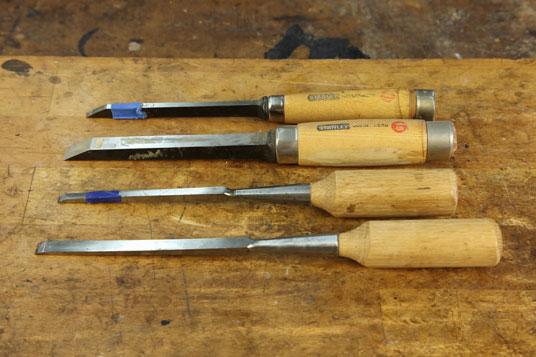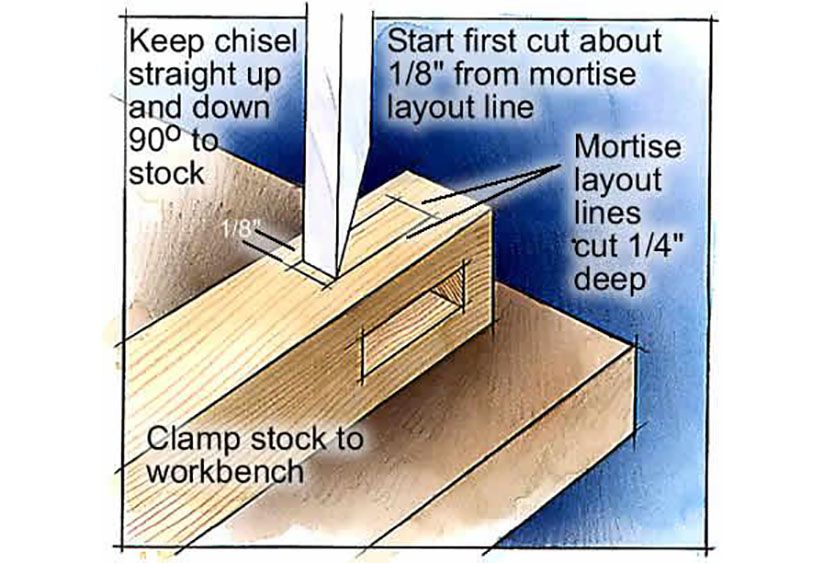Are you curious why woodworkers use a mortise chisel? Well, you’ve come to the right place!
Picture this: you’re working on a woodworking project, whether it’s a beautiful piece of furniture or a stunning sculpture. You want to create strong and sturdy joints that will stand the test of time. That’s where the trusty mortise chisel comes in.
But what exactly is a mortise chisel? How does it work? And why do woodworkers rely on it? In this article, we’ll dive deep into the world of mortise chisels and uncover the reasons behind their indispensability in woodworking projects. So, let’s get started and explore the fascinating world of mortise chisels together!

Why Do We Use a Mortise Chisel? An Essential Tool for Woodworking
When it comes to woodworking, having the right tools can make all the difference in the quality and efficiency of your work. One such tool that is essential for creating strong and precise joints is the mortise chisel. Mortise chisels are specially designed to create square or rectangular holes, known as mortises, which are then paired with matching tenons to create strong, interlocking joints. In this article, we will explore the various reasons why mortise chisels are so widely used in the woodworking world.
The Significance of Mortise and Tenon Joints
Mortise and tenon joints have been used in woodworking for centuries due to their exceptional strength and durability. These joints are commonly found in furniture, doors, windows, and other wooden structures where the goal is to create a long-lasting connection between two pieces of wood. Unlike screws or nails, mortise and tenon joints rely solely on the mechanical interlocking of the joint itself, making them exceptionally sturdy and resistant to movement or separation.
The mortise chisel plays a crucial role in creating the mortise portion of this joint. Its sharp and durable blade allows woodworkers to carefully remove material and shape the mortise hole precisely to fit the tenon. This ensures a tight fit and maximizes the strength of the joint. Without a mortise chisel, creating clean and accurate mortises would be a much more challenging and time-consuming task.
The Versatility of Mortise Chisels
One of the reasons why mortise chisels are valued by woodworkers is their versatility. While they are primarily used for creating mortise holes, these chisels can also be utilized for other tasks in the woodworking process. The sturdy construction and sharp blades of mortise chisels make them suitable for tasks such as cleaning out corners, paring, and general woodworking.
Mortise chisels come in various sizes and shapes to accommodate different mortise dimensions and project requirements. Some chisels have wider blades for larger mortises, while others have narrower blades for more intricate and delicate work. With the right selection of mortise chisels, woodworkers have the flexibility to tackle a wide range of woodworking projects with precision and efficiency.
Benefits of Using a Mortise Chisel
Using a mortise chisel offers several benefits to woodworkers:
- Precision: Mortise chisels allow for precise removal of wood, resulting in accurate mortises that fit the corresponding tenons perfectly.
- Strength: Mortise and tenon joints created with a chisel are incredibly strong and resistant to movement, ensuring the longevity of the finished piece.
- Efficiency: With a mortise chisel, woodworkers can quickly and efficiently create mortises with minimal effort, saving both time and energy.
- Versatility: Mortise chisels can be used for tasks beyond creating mortise holes, making them a versatile tool in the woodworking workshop.
- Professional Results: The use of a mortise chisel allows woodworkers to achieve professional-level results, ensuring the highest quality in their work.
Tips for Using a Mortise Chisel
Here are some valuable tips to keep in mind when using a mortise chisel:
- Sharpen Regularly: A sharp chisel is essential for clean and precise cuts. Regularly sharpen your mortise chisel to maintain its effectiveness.
- Secure Your Workpiece: Ensure your workpiece is properly secured before using a mortise chisel to avoid any slipping or movement that may affect the accuracy of your mortises.
- Take It Slow: When removing material with a mortise chisel, take your time and make small, controlled cuts to prevent any accidental damage or slips.
- Use a Mallet: For more challenging or dense wood, consider using a mallet to exert additional force when driving the chisel into the material.
- Practice and Patience: Like any woodworking skill, using a mortise chisel effectively requires practice and patience. Take the time to hone your technique and improve your craftsmanship.
Mortise Chisels: A Must-Have Tool for Every Woodworker
In conclusion, mortise chisels are an essential tool for woodworking, particularly when creating strong and durable mortise and tenon joints. These versatile chisels allow woodworkers to achieve precise and professional results, saving time and effort in the process. By understanding the significance of mortise and tenon joints, the benefits of using a mortise chisel, and following some essential tips, you can successfully incorporate this invaluable tool into your woodworking endeavors.
Key Takeaways: Why Do We Use a Mortise Chisel?
- A mortise chisel is a specialized tool used in woodworking to create square or rectangular holes called mortises.
- It is used to remove wood in a precise and controlled manner, allowing for the insertion of tenons or other joinery components.
- Mortise chisels have a sturdy construction with a thick blade and long handle for increased leverage and strength.
- They can be used with a mallet or hammer, making it easier to chisel out the wood and create clean, accurate mortises.
- Mortise chisels are commonly used in traditional joinery techniques, such as mortise and tenon joints, to ensure strong and durable connections between pieces of wood.
Frequently Asked Questions
Welcome to our frequently asked questions section where we provide answers to your queries about the usage of a mortise chisel. Here, you’ll find valuable information about why this tool is essential for woodworking projects and how it can improve your craftsmanship.
1. What is a mortise chisel, and why is it important?
A mortise chisel is a specialized woodworking tool used to create square or rectangular holes, known as mortises, in a piece of wood. Its importance lies in its ability to create precise and clean cuts, allowing for the insertion of tenons or other joinery elements to create strong and durable connections. Using a mortise chisel ensures the stability and structural integrity of your woodworking projects, making it a crucial tool for any woodworker.
By using a mortise chisel, you can create well-fitted and tight joints that withstand the test of time. This tool allows for greater control and accuracy in shaping and sizing the mortise, resulting in a superior finish and a more professional outcome for your woodworking projects.
2. When should I use a mortise chisel instead of other tools?
A mortise chisel should be used when you need to create a square or rectangular hole in wood, especially when it’s part of a joinery technique. While other tools like drills or routers can efficiently remove material, a mortise chisel offers greater precision and control, ensuring the perfect fit for tenons or other elements used for joining pieces of wood together. Additionally, a mortise chisel can handle the necessary depth required for strong and stable connections.
While power tools can be faster, mortise chisels are indispensable when it comes to tight-fitting joints, custom-sized mortises, and handcrafted woodworking projects that demand meticulous attention to detail. So, if you’re looking to achieve a high level of craftsmanship and create durable joints, a mortise chisel is the tool for the job.
3. How do I use a mortise chisel effectively?
To use a mortise chisel effectively, follow these steps:
1. Mark the position and size of the mortise on the wood, ensuring it aligns with your design.
2. Use a marking gauge or other measuring tools to define the depth of the mortise.
3. Hold the mortise chisel firmly with one hand and place its sharp edge on the marked line.
4. With a mallet or hammer, gently tap the chisel to make an initial cut along the grain.
5. Gradually increase the force of the strikes, working towards the required depth and following the marked lines.
6. Once the bulk of the material is removed, use paring chisels or other tools to clean and refine the mortise to the desired size and shape.
Remember to work slowly and cautiously, maintaining control over the chisel to avoid any mishaps or damage to your wood pieces, ensuring a precise and professional finish.
4. Can a mortise chisel be used with different types of wood?
Yes, a mortise chisel can be used with different types of wood, including hardwoods and softwoods. However, the hardness and density of the wood will impact the amount of effort required and the wear on the chisel over time. Hardwoods, such as oak or maple, may offer more resistance and require more force to make the cuts, while softwoods like pine or cedar may be easier to work with.
It’s essential to select the appropriate chisel size for the specific wood you’re working with and keep the chisel sharp to maintain its effectiveness. Additionally, some woods prone to splintering, like plywood, may require extra care and caution to avoid any unwanted damage. Ultimately, matching the chisel and technique to the wood type will result in the best outcomes for your woodworking projects.
5. How do I maintain and care for a mortise chisel?
To ensure the longevity and performance of your mortise chisel, follow these maintenance tips:
1. Keep the chisel sharp by regularly honing and sharpening the blade, ensuring a crisp edge for precise cuts.
2. Clean the chisel after each use to remove any wood debris or dust that may affect its functionality.
3. Store the chisel in a dry place, away from moisture and extreme temperature changes, which can cause rust or damage.
4. Avoid using excessive force or hitting the chisel with a metal hammer, as it may chip or damage the blade.
5. Periodically inspect the chisel for any signs of wear or damage, such as cracks or chips, and replace it if necessary.
By following these practices, you can ensure that your mortise chisel remains in excellent condition, providing you with years of reliable use in your woodworking endeavors.

Why you should try mortising by hand
Summary
So, why do we use a mortise chisel? Well, a mortise chisel is a handy tool used in woodworking to create square holes, or mortises, in wood. This chisel has a sturdy design with a thick, square blade that allows for precise and clean cuts. With a mortise chisel, you can make strong joints, like mortise and tenon joints, which are crucial for building furniture and other wooden structures. So, it’s an essential tool for any woodworker.
Moreover, a mortise chisel is designed to withstand the force applied during the cutting process. It has a long and sturdy handle that provides stability and control while working. The sharp, square blades of the chisel are made from durable materials to ensure longevity. With a mortise chisel in your toolbox, you’ll be able to create strong and durable wooden joints for all your woodworking projects.
